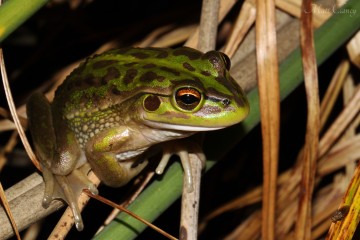![]() By Andrew Alexander, MSc Student at Strynadka Lab
By Andrew Alexander, MSc Student at Strynadka Lab
In April of this year, Canada released the Canadian Antimicrobial Resistance Surveillance System Report, the first single cohesive document of its kind concerning antimicrobial resistance in Canada on a national level. Following a common theme among these types of reports, it heralds the need for novel, alternative compounds to treat resistant bacterial infections. The Kizhakkedathu group at the Centre for Blood Research, together with the Straus Lab in the Department of Chemistry at UBC undertook this quest in their recent paper published in Biomacromolecules. It provided insight into how short sequences of amino acids, known as antimicrobial peptides (AMPs), might one day be used to treat infections alongside conventional antibiotics.
Aurein 2.2, which is secreted by an Australian growling grass frog, Litoria raniformis, exhibits antimicrobial activity against antibiotic resistant Gram positive bacteria, such as methicillin resistant Staphylococcus aureus (MRSA). AMPs are exploited in nature to protect against microbial infections, forming a part of the innate immune system. Importantly, it is difficult for bacteria to become resistant to them, unlike to many currently prescribed antimicrobial drugs. Unfortunately, naked Aurein 2.2 is highly cytotoxic to human cells.
In an effort to reduce the cytotoxicity of Aurein 2.2, while maintaining its antimicrobial properties, the authors describe the first instance of joining an antimicrobial peptide to hyperbranched polyglycerol (HPG). The authors have shown that once this AMP is conjugated with HPG it appears to be significantly less toxic. In vitro assays with Aurein 2.2 conjugated to HPG show less red blood cell lysis, complement activation, and blood coagulation, while displaying increased cell viability compared to the naked Aurein 2.2. Most importantly, Aurein 2.2 conjugated to HPG retained antimicrobial activity against S.aureus.
Prashant Kumar, the first author on this publication, went on to explain that electrostatic interactions cause the AMPs to preferentially associate with bacterial cells instead of human cells. Once the peptides are associated with the bacterial membrane, hydrophobic interactions work to disrupt the bacterial membrane. As the membrane is a fundamental structure essential for bacterial viability, it is difficult for bacteria to gain resistance.
“The next step is [to] find an optimum polymer and peptide conjugate. I’m running an assay where I’m testing 100 peptides, in search for the most active one”– commented Prashant. He added that the biggest challenge in this research was characterizing the potential conjugates, finding the ones that are antimicrobial and biocompatible with human cells.
Prashant confirmed that one of the major impacts of this publication was demonstrating progress toward a possible “balance between antimicrobial activity and biocompatibility”. The work presented in this paper helps to illuminate the path to using AMPs to fight resistant bacterial infections and highlights the need for further research into the use of these antimicrobial peptides to fight resistant infections.



